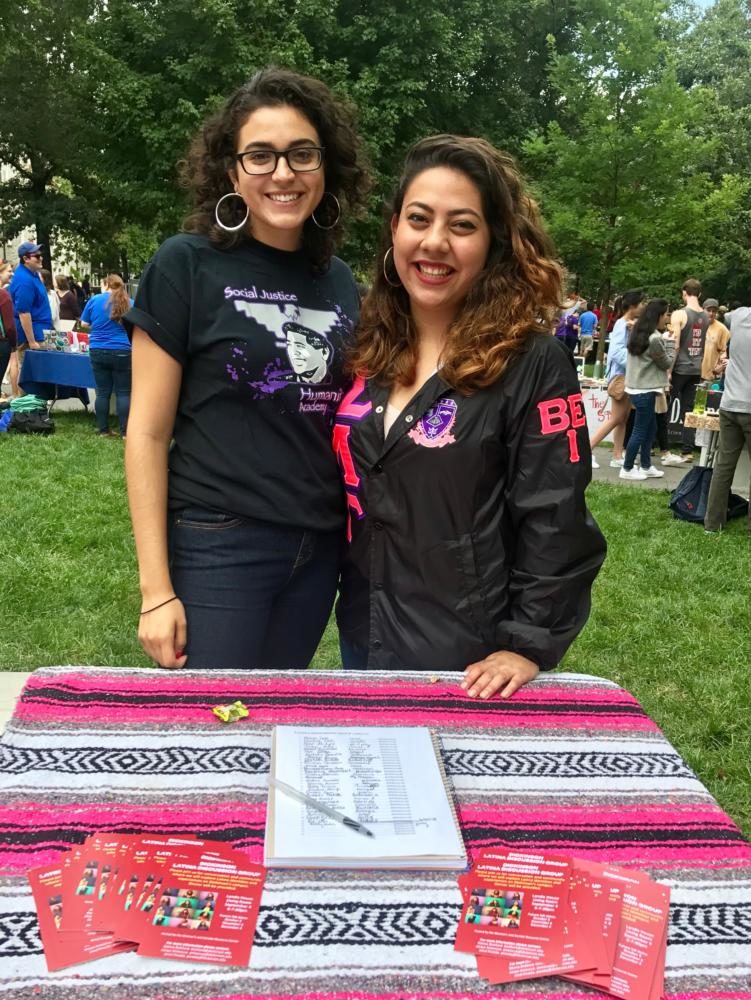Discussion Group Focuses on Centering Latina Narratives in Safe and Empowering Space
“As Latinas, we will not go unnoticed,” stated Jacqui Amezcua ’19 and Janel Pineda ’18, the student facilitators of Dickinson Latina Discussion Group.
Latina Discussion group has been meeting on campus since the fall semester of last year. This semester, the group will be meeting in Landis House from 6-7:30 p.m. on September 4, October 9, November 6 and December 4.
“I think the process [of starting Latina Discussion Group] was a communal thing just because I know my first year and Janel’s sophomore year we talked a lot about spaces on campus, and Janel was who I would talk to about my not feeling accepted in terms of my Latinidad [identity] on campus,” says Amezcua.
Bickford mentions that after hearing anecdotes about some negative experiences that Latina women on this campus have been having, she talked to a few Latina women about what would be helpful to them.
The Latina Discussion Group started “[l]ast year during the fall I continued to be in contact with Donna and she was like, ‘Okay, so give me dates that work and we will host you at Landis,’” declares Amezcua.
“A couple of things [led to the club’s creation]. One is that generally, not just here, Women’s and Gender Resource Centers being spaces for white women and we are either intentionally excluding women of color or doing things unintentionally that make women of color feel un-included and I really want to work against that in anti-racist ways as much as I can.”
“I think once I was at Dickinson and as I worked to claim my Latina identity,” said Pineda, “there were still many issues that I faced as a Latina on this campus that sometimes make it difficult to be here…So, I felt really invested in coming together with other Latinas on this campus to have conversations about what we need and how we can build each other up.”
Amezcua went on to say, “I don’t want my experiences to be the same experiences as another first year. I want a first year Latina woman to come to this campus and be like […] ‘There is a space for me.’”
Another reason Pineda and Amezcua decided to create this space for Latina women was because of another event that occurred during the fall 2015 semester which was an “Around the World” themed party “in which students dressed up as ‘Mexicans’ by wearing sombreros, drinking beer, drinking tequila and specifically making comments about green cards and immigration. All of which are issues that deeply affect my life as the daughter of immigrants and that was a really heartbreaking moment for me on this campus because it felt to me that we were no longer seen as people. We were seen as a theme, a joke. And as I watched other Latinas, particularly on this campus, struggle with that, I realized that we really just needed to have more support when hostile things like this do occur all the time [from] microaggressions [to] being called racial slurs on campus, which has happened several times to many different Latina women on this campus,” Pineda explains.
“I really wanted to be in the space partly just to hold the space but partly because I need to learn about these experiences because hopefully there are things I could do at my work in the [Gender Resource Center] GRC that can help at least mitigate against some of the negative experiences that [Latina students] have and that are really painful,” says Bickford.
The topics of the meetings depend based on what is happening on campus, in the world, or in the members’ personal lives, “Typically, [in] the first meeting a welcoming to the space is created […] I think, most importantly it’s like people could check in and maybe if they want to share parts of their identity that they can’t share outside the space […] and I think that first meeting is always fun because you’re looking at where people are coming from and even though we’re all Latino/Latinx we are learning about how our cultures overlap and even how they’re different […] we all look differently, we all eat different foods, we’re all from different regions,” Amezcua states.
Ana Gamino ’18 went to the first Latina Discussion Group meeting of the semester and reflected on how diverse the group was in terms of class years, which led to discussions around how the first years’ time on campus has been going and asking for advice as well as discussing the topic of culture shock. “We all kind of talked about what we experienced and how we experienced culture shock and how we dealt with it.”
Gamino saw the first meeting as “Cultivating a safe space for Latina women and how we could help each other if we ever are homesick, thinking about what we could do for each other just to create an idea of what we want this space to be.”
“I envision this space as a continued mechanism of support and empowerment where Latinas can continue to come together in this very difficult political climate to build community and to process the challenges we face but also to celebrate the joys of our experiences,” Pineda states.
Gamino echoes this vision with her reflection of how other Latina women have spoken about the discussion group thus far saying, “Several Latina women expressed they were really happy to have this space because you walk around campus and see other people of color but to have your culture represented [as a Latina] this is the space you could go to.”
Amezcua and Pineda highlight that the discussion group is currently “more focused on centering Latina narratives” at the forefront of their conversations.




